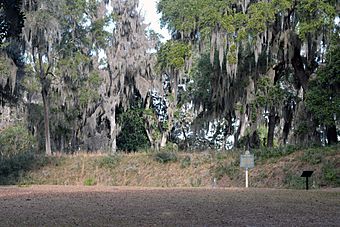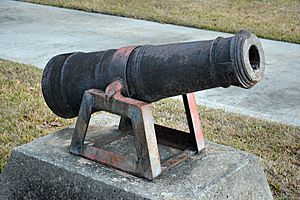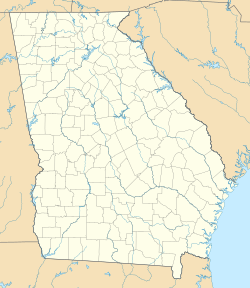Fort Morris Historic Site facts for kids
Quick facts for kids |
|
|
Fort Morris Historic Site
|
|

Earthworks at Fort Morris
|
|
| Nearest city | Midway, Georgia |
|---|---|
| Area | 7 acres (2.8 ha) |
| NRHP reference No. | 70000208 |
| Added to NRHP | May 13, 1970 |
Fort Morris Historic Site is a special place in Liberty County, Georgia. It's a Georgia state historic park where you can explore history! This fort sits right on the Medway River. It was super important for protecting southeast Georgia for many years.
People used Fort Morris during several big conflicts. These included the French and Indian War, the American Revolutionary War, and the War of 1812. It was even used a little during the American Civil War. The site covers about 70 acres and is a great spot to learn about the past. On May 13, 1970, Fort Morris was added to the National Register of Historic Places. This means it's recognized as a very important historical landmark.
Contents
Fort Morris: A Look Back in Time
Early Days: Protecting a Plantation
The very first fort here was built in 1741. It was used during a conflict called the War of Jenkins' Ear. Its main job was to protect a large farm, or plantation, owned by Captain Mark Carr.
On March 18, 1741, the plantation faced an attack. A group of Native Americans, who were friends with the Spanish in Florida, raided the area. Some soldiers defending the fort lost their lives. The attackers took items from the fort and plantation using a large boat.
Growing Stronger: French and Indian War
Years later, in 1756, a new fort was built. Local people wanted protection from attacks by Creek Indians. This was happening during the French and Indian War.
The fort got even bigger in 1758. It was expanded to protect a new town called Sunbury. This town was built on land that Captain Carr once owned.
Fighting for Freedom: The American Revolution
The need for defense grew again when the American Revolution began. Fort Morris was crucial for protecting the Medway River and Sunbury. British forces attacked Fort Morris on January 9, 1779. They captured it the very next day.
The British renamed it Fort George and stayed there until September 1779. After the Revolution, the fort slowly fell apart.
New Threats: The War of 1812
The area needed protection again during the War of 1812. A new fort, called Fort Defiance, started construction in 1814. It was built on the same spot as the old Fort Morris.
However, the war ended before Fort Defiance was finished. It was left incomplete.
A Small Role: The American Civil War
Fort Morris and Sunbury played a smaller part in the American Civil War. A few Confederate soldiers were stationed in Sunbury. They might have used the fort for a short time.
Later, in 1864, Union soldiers arrived. This was during General William T. Sherman's famous Sherman's March to the Sea. They took some cannons from the fort. These cannons were moved to Union forts along the Atlantic coast.
Exploring the Park Today

Fort Morris Historic Site is now a state park. It helps us remember the different forts that stood here. You can still see the old earthworks today. These are the dirt walls that show how big the fort once was. They defended the Medway River long ago.
Fun Events at the Park
The park hosts three exciting historical events each year.
- A Labor Day celebration includes special tours. Guides dress in old military uniforms. They even fire muskets and cannons!
- In November, there's a re-enactment of Colonel McIntosh's stand from 1778. This event includes weapon firings and a mock battle.
- A Colonial Christmas is also celebrated at the fort. You can enjoy old-fashioned treats, music, and a warm bonfire.
What Else Can You Do?
The park has a visitor center with a film and exhibits. You can learn even more about the fort's history there. There's also a nature trail and picnic areas. Groups can even camp at the Pioneer Campground. The 1-mile nature trail lets you see local wildlife and plants.
See also



